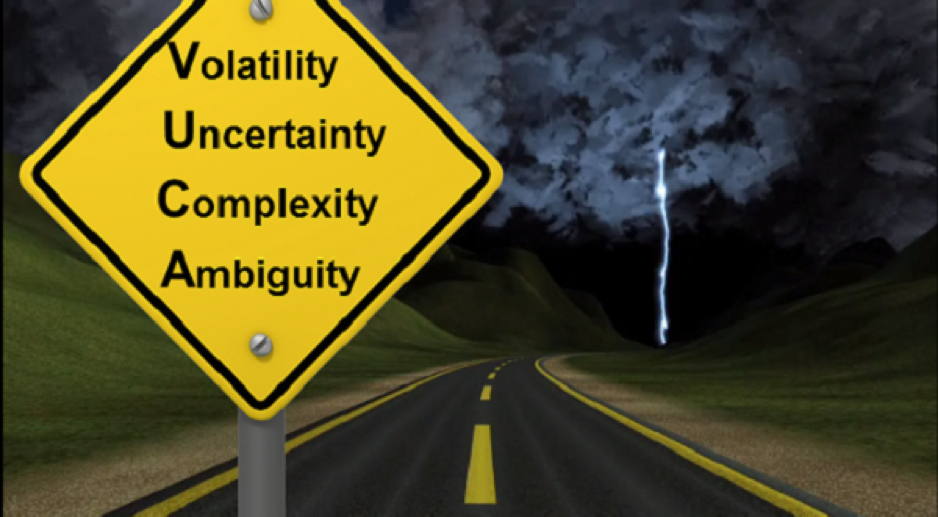Communicating in volatile times, uncertain times, complex times and ambiguous times is one of the big challenges of our age.
This is so much so that there’s been a revival of the buzzword to describe such times.
That word is VUCA.
It’s the acronym for Volatility, Uncertainty, Complexity and Ambiguity.

The term VUCA came into being with the rapid changes at the end of the Cold War – symbolised by the fall of the Berlin Wall in 1989.

Being based as a foreign correspondent in Berlin in the aftermath of communist domination of Eastern Europe, it meant that every day there were extraordinary new events for me to cover.
These included the introduction of hard currency to eastern Germany, the blossoming of previously banned private businesses and the mass movement of liberated migrants across Europe.
Recent developments since then have created even higher VUCA levels.
If there were an official VUCA Index, the United Kingdom’s jerky, cumbersome and seemingly never-ending departure from the European Union would certainly have raised it.
In line with VUCA, even the latest date just set for Brexit of Halloween 2019, could end up being earlier or later than that – or still may not happen at all.
The erratic nature of President Donald Trump’s decision-making would have lifted a VUCA Index higher still.
So, too, would the disruption brought about by the impact of high technology on traditional industries.
For some useful guidance on how to manage in a VUCA world, check out this video.
When it comes to communicating amidst high levels of VUCA, the advice in the video – about making things crystal clear when you communicate – is commendable.
The good news is that communicating effectively and clearly in times of VUCA is a learnable skill!
BE CONSISTENT: DON’T DO A “DONALD”
One important aspect of communicating well in these VUCA times is to be as consistent as possible.
With the speed of communications in the digital age, what you said in the last hour, the last week and in the last decade often lives on in cyberspace.
The internet also makes it very easy for people to re-visit what you said before your latest statement – making the need for consistency in communications all the more important for your credibility.
When situations change wildly amidst the VUCA, your important utterances need to be designed to withstand it.
Alas in this respect the American President sets a particularly poor example.
This applies to what President Trump has said on the currently contentious subject of WikiLeaks after the arrest of the organisation’s founder, Julian Assange, inside the Ecuadorian Embassy in London.

But in this following clip you’ll see that, unbelievably, President Trump claims to know nothing about WikiLeaks.
Yet here’s what Candidate Trump said when WikiLeaks disseminated adverse information about Candidate Clinton in the 2016 election campaign when Donald Trump declared his “love” for WikiLeaks:
Surely you can’t be in love with an organisation that you know nothing about!
Even though the time to organise your communications on fast-moving subjects is often pressured in the VUCA age, it’s nonetheless important to ensure you plan, prepare and practice when there’s something important you and your organisation need to say.
As you do so, one of the vital things is to include necessary caveats in what you’re saying so that your utterances maximise your prospects of remaining truthful.
So, where appropriate, ensure you are speaking truth by including caveats such as “from the latest information we have…”, “as far as we know…” and “based on assumption X, then…”
This applies to whether you’re making a presentation, answering questions or conducting a media interview.
Consistency is also important when you’re communicating in one of those most modern of methods – talking straight to the camera.
This is one of the ways where – as a former broadcast journalist who was schooled in the art of talking-to-camera – I can provide help.
TALKING-TO-CAMERA: LEARN IT AND SPEAK TO THE WORLD
The good news is that talking directly to the camera – to get your message across on the web – is a learnable skill.
Some people mistakenly think you have to be born with the knack of doing it.
But talking to the camera lens about your expertise in a user-friendly manner is something that you can be trained to do at a higher level.
It used to be a skill almost exclusively practised by TV reporters and presenters.
This puts one-time TV reporters in a good position to show you the tricks.

One of these tricks is to picture a friendly face – ideally of a specific friend – listening to your golden words as you say them.
When you do the talking-to-camera training first, followed by rehearsals, you’re then well-placed to do real recordings to be disseminated on the web.
Completing these steps can be done over one or two days.
Below is a sample of video that was recorded on this basis – thanks to the expert on automatic gate systems, Alan Smith of Gate-a-Mation, and the production skills of my technical colleagues at Fiveonabike.
Having Alan Smith demonstrate one of his automated gate systems while he talks to the camera makes the video easier and more interesting for the viewer to follow.
There’s more about sessions on talking-to-the-camera – and of producing videos capitalising on your newly developed skills – at:
http://www.michaeldoddcommunications.com/talking-to-the-camera/
Here’s a familiar face talking directly to the camera about the art of addressing your audience through the lens of a camera.
When you master talking directly to the camera, it can be an efficient, effective and powerful way to get your message out there – to your people, to your potential customers and to the world.
Because you can potentially do recordings on your mobile phone, you can use your talking-to-camera skills to get your message out there with considerable speed.

This is something especially important in fast-moving VUCA times!

